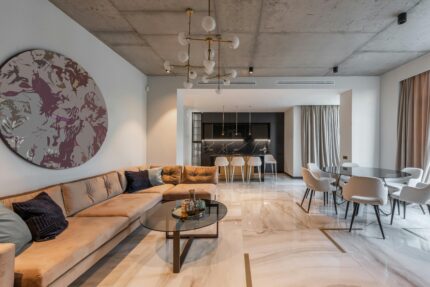Imagine yourself staring at a large blank wall or an open floor plan. Are you wondering what to do with the space? Decorating negative space can be a challenging yet rewarding aspect of interior design since it plays a critical role in a room’s aesthetic and functional balance. However, it’s easy to make mistakes that can turn a potential focal point into an eyesore.
Here are five common mistakes people make when decorating negative space and how to avoid them.
Overloading the Space
One of the most common mistakes homeowners make is overloading the negative space with too many decorative elements. To fill the void, people often add numerous pieces of art, furniture, or accessories, leading to a cluttered and overwhelming look. Negative space shouldn’t cause chaos but should serve as a breath of fresh air in a room, providing balance and allowing other elements to stand out.
Solution: Embrace simplicity. Choose one or two key pieces that complement the room’s overall design. A large, striking piece of art or a statement piece of furniture can enhance the space without overwhelming it. Remember, less is often more when it comes to negative space.
Ignoring Scale and Proportion
Another frequent error is ignoring the scale and proportion of the items placed in the negative space. Using pieces too small or too large for the area can throw off the room’s balance. For instance, a tiny piece of artwork on a vast blank wall will look lost and insignificant, while an oversized piece can dominate and dwarf other elements in the room.
Solution: Consider the dimensions of the space and the items you’re using. Big walls may require larger pieces or a thoughtfully arranged gallery wall to maintain proportion. For open floor plans, ensure that furniture and accessories are appropriately scaled to create a natural flow.
Lack of Cohesion
A negative space that doesn’t tie in with the rest of the room can feel disjointed and out of place. It’s important that whatever you choose to fill the negative space with aligns with the room’s color scheme, style, and overall design aesthetic. Mismatched elements can create visual chaos and disrupt the harmony of the space.
Solution: Maintain a cohesive look by incorporating elements that reflect the room’s design. Opt for sleek, minimalist pieces if your room has a modern aesthetic. For a more traditional space, consider classic art or vintage furniture. Consistency in style will help the negative space blend seamlessly with the rest of the room.
Forgetting Functionality
While aesthetics are crucial, functionality should not be overlooked when decorating negative space. Often, homeowners focus solely on the visual aspect and forget to consider how the space will be used. This can result in beautiful but impractical spaces that don’t meet the household’s needs.
Solution: Think about how the space can serve a purpose. An open floor plan, for example, might benefit from a cozy reading nook or a functional workspace. For large blank walls, consider adding built-in shelving or a functional gallery wall with hooks for bags or keys. Balancing beauty with utility ensures that the space is both attractive and practical.
Neglecting Lighting
Lighting is a critical element that’s often neglected when decorating negative space. An interior decorator in Plantation, FL, says poor lighting can make a space feel dark, uninviting, and unbalanced, while well-planned lighting can highlight features, create ambiance, and enhance the overall aesthetic.
Solution: Incorporate a variety of lighting sources to enhance negative space. Wall sconces, floor lamps, or strategically placed spotlights can draw attention to artwork or architectural features. For open floor plans, ensure that different areas are well-lit to create a cohesive and welcoming environment. Layered lighting can add depth and dimension, making the space more dynamic and appealing.
Decorating negative space requires a thoughtful approach that balances aesthetics with functionality. By avoiding these common mistakes, you can transform negative space into a positive feature of your home, creating a harmonious and inviting environment.




